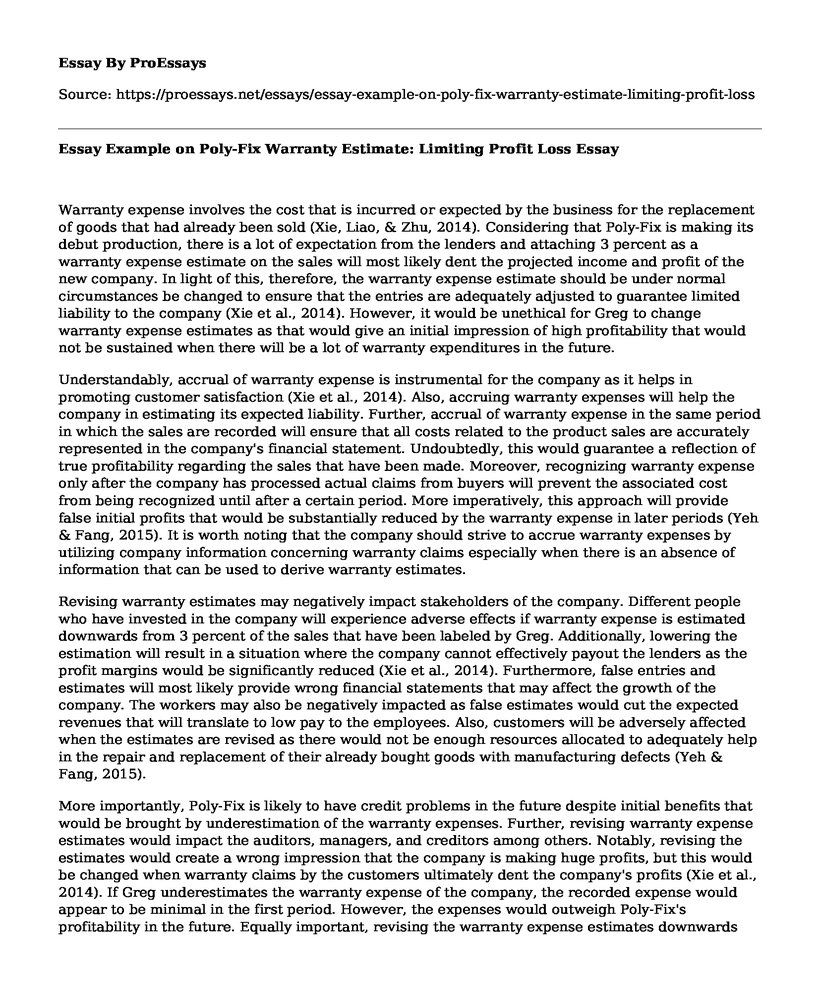Warranty expense involves the cost that is incurred or expected by the business for the replacement of goods that had already been sold (Xie, Liao, & Zhu, 2014). Considering that Poly-Fix is making its debut production, there is a lot of expectation from the lenders and attaching 3 percent as a warranty expense estimate on the sales will most likely dent the projected income and profit of the new company. In light of this, therefore, the warranty expense estimate should be under normal circumstances be changed to ensure that the entries are adequately adjusted to guarantee limited liability to the company (Xie et al., 2014). However, it would be unethical for Greg to change warranty expense estimates as that would give an initial impression of high profitability that would not be sustained when there will be a lot of warranty expenditures in the future.
Understandably, accrual of warranty expense is instrumental for the company as it helps in promoting customer satisfaction (Xie et al., 2014). Also, accruing warranty expenses will help the company in estimating its expected liability. Further, accrual of warranty expense in the same period in which the sales are recorded will ensure that all costs related to the product sales are accurately represented in the company's financial statement. Undoubtedly, this would guarantee a reflection of true profitability regarding the sales that have been made. Moreover, recognizing warranty expense only after the company has processed actual claims from buyers will prevent the associated cost from being recognized until after a certain period. More imperatively, this approach will provide false initial profits that would be substantially reduced by the warranty expense in later periods (Yeh & Fang, 2015). It is worth noting that the company should strive to accrue warranty expenses by utilizing company information concerning warranty claims especially when there is an absence of information that can be used to derive warranty estimates.
Revising warranty estimates may negatively impact stakeholders of the company. Different people who have invested in the company will experience adverse effects if warranty expense is estimated downwards from 3 percent of the sales that have been labeled by Greg. Additionally, lowering the estimation will result in a situation where the company cannot effectively payout the lenders as the profit margins would be significantly reduced (Xie et al., 2014). Furthermore, false entries and estimates will most likely provide wrong financial statements that may affect the growth of the company. The workers may also be negatively impacted as false estimates would cut the expected revenues that will translate to low pay to the employees. Also, customers will be adversely affected when the estimates are revised as there would not be enough resources allocated to adequately help in the repair and replacement of their already bought goods with manufacturing defects (Yeh & Fang, 2015).
More importantly, Poly-Fix is likely to have credit problems in the future despite initial benefits that would be brought by underestimation of the warranty expenses. Further, revising warranty expense estimates would impact the auditors, managers, and creditors among others. Notably, revising the estimates would create a wrong impression that the company is making huge profits, but this would be changed when warranty claims by the customers ultimately dent the company's profits (Xie et al., 2014). If Greg underestimates the warranty expense of the company, the recorded expense would appear to be minimal in the first period. However, the expenses would outweigh Poly-Fix's profitability in the future. Equally important, revising the warranty expense estimates downwards would result in a situation where the management of the company allocates fewer finances to cover for the liabilities (Yeh & Fang, 2015). Therefore, when the warranty claims surpass the allocated resources, the company would experience difficult times, and worse still it may be edged out of the market.
References
Xie, W., Liao, H., & Zhu, X. (2014). Estimation of gross profit for a new durable product considering warranty and post-warranty repairs. IIE Transactions, 46(2), 87-105. https://www.tandfonline.com/doi/abs/10.1080/0740817X.2012.761370
Yeh, C. W., & Fang, C. C. (2015). Optimal decision for warranty with consideration of marketing and production capacity. International Journal of Production Research, 53(18), 5456-5471. https://www.tandfonline.com/doi/abs/10.1080/00207543.2015.1010743
Cite this page
Essay Example on Poly-Fix Warranty Estimate: Limiting Profit Loss. (2023, Mar 28). Retrieved from https://proessays.net/essays/essay-example-on-poly-fix-warranty-estimate-limiting-profit-loss
If you are the original author of this essay and no longer wish to have it published on the ProEssays website, please click below to request its removal:
- Personal Statement on Supply Chain and Operational Management
- Advantages and Disadvantages of Couchsurfing Paper Example
- General Industry Insurance Overview - Article Analysis Essay
- Organizations: Enhancing Cybersecurity With ML & AI - Annotated Bibliography
- Essay Example on Maximise Warehouse Space: Material Handling & Storage Solutions
- Essay Sample on Ibiza Essentials Sustainable: 10+ Years of Marketing Excellence
- Essay on Amazon.com: 1994-750000 Employees, E-Commerce Success & Global Expansion







